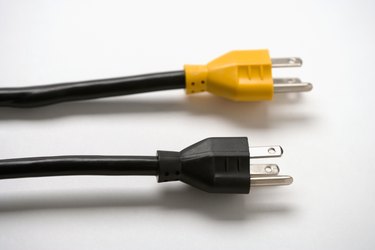
The difference in SJT and SVT cords lies in their capacity to handle temperature and loads. The letters of their names (SJT and SVT) represent their Underwriters' Laboratories (UL) code and designation. The UL is an independent, non-profit science center that performs critical testing to create standards across several industries. The codes they create allow manufacturers to label cords simply and still convey the information necessary for users to understand the capabilities of the power cords.
Insulation
Video of the Day
Both cords are insulated using polyvinylchloride (PVC) coatings. The insulation on SJT cords is thicker than on SVT and made to meet UL Class 43 thermoplastic per UL Standard 1581. SVT cords are insulated to meet UL standard 62. The difference between the two standards, which cover flexible cords, is that 1581 contains special requirements for the construction of rounded cords.
Video of the Day
Wire Gauge
SVT cords can contain wire gauge sizes 17 and 18 only. SJT can use a range from size 10 up to size 18 wire.
Color Coding
Both cords come in black, white or gray per UL standards. SJT cables can also be coated in different colors to match European electric standards as the regulations governing heavy use power cords are different than lighter use (SVT) cords.
Applications
SJT cords are designed for heavier use appliances, machinery or other types of electrical equipment considered to have heavy use. SVT cords are common on smaller kitchen appliances, vacuum cleaners or electrical devices used in more controlled and protected environments.